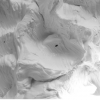Tmymtur –Yusei
ENSL AMDC
 So the blurb reads that Yusei (“Spring voice”) is all about frequencies that you can’t hear, up in those registers over 20kHz beyond human hearing. Which reminds me of those audiophile tropes about how analogue LPs transmit sounds well beyond human threshold which make for ‘fuller’ tones and all that jazz. I’m perennially ambivalent about these ideas – I like the idea that somewhere in the hinterland between physics and psychoacoustics there’s a semi-appreciable difference in acoustic presence. But I’m always cautious that audiophiles tend to be dogturds of humans battering boorish ‘quality’ into the ears of the not-particularly-bothered. Apophatic in the face of audiophiles, perhaps.
So the blurb reads that Yusei (“Spring voice”) is all about frequencies that you can’t hear, up in those registers over 20kHz beyond human hearing. Which reminds me of those audiophile tropes about how analogue LPs transmit sounds well beyond human threshold which make for ‘fuller’ tones and all that jazz. I’m perennially ambivalent about these ideas – I like the idea that somewhere in the hinterland between physics and psychoacoustics there’s a semi-appreciable difference in acoustic presence. But I’m always cautious that audiophiles tend to be dogturds of humans battering boorish ‘quality’ into the ears of the not-particularly-bothered. Apophatic in the face of audiophiles, perhaps.
[soundcloud url=”http://api.soundcloud.com/tracks/80871665″ params=”” width=” 100%” height=”166″ iframe=”true” /]
The press blurb has a bit about “These ultra-high frequency waves [recorded by fancy super-duper mics] are often included in sounds of nature such as the flow of the river, the forest, waterfalls, and the wind blowing through the trees. Most of these which we consider as comfortable nature sound include these ultra-high frequencies, and it is also said that these ultra- high frequencies have the effect to make the human brain relaxed”. Does it work like that? Definitely. It’s properly floaty. Part of me was a bit disappointed that there was anything within my audible range (I’m a fan of the arch and conceptual) but the bottom line is it’s a lovely thing. I’m happy being persuaded by the UHF frequency spiel on the basis that it’s quite beautiful. In spite of there not being much ‘there’ (I mean it’s fairly minimal in content, a few notes or so) it really fills the room in quite an impressive way – whether that’s because there’s a load of frequencies I can’t hear or just successful compositions makes little difference – it’s a cracker.Hacker Farm – UHF
Exotic Pylon
 Another record with UHF involved, this time in the title (you see what I did there?) but from a very different world of heavy oscillations, all apparently in the realm of cracked analogue gear. I quite like that these are two records, very different, both under the UHF umbrella, the first dealing with apparently non-audible areas of the upper-register; this (presumably) recognising the analogue nature of things rather than particularly describing register.
Another record with UHF involved, this time in the title (you see what I did there?) but from a very different world of heavy oscillations, all apparently in the realm of cracked analogue gear. I quite like that these are two records, very different, both under the UHF umbrella, the first dealing with apparently non-audible areas of the upper-register; this (presumably) recognising the analogue nature of things rather than particularly describing register.
Hacker Farm seem to be partly associated with whatever remnants of dubstep are still worth listening to – at least in terms of the bills they’re playing – but it’d be a shame to file them off in that particular ditchwater – it’s not really dubstep or even neo-IDM stuff. There’s that old John Peel quote about IDM presupposing stupid dance music and, while this isn’t moronic, it’s definitely got a sense of full-on throaty tone-love that’s closer to the idea of dancing than a majority of bedroom tech-faffers. Definitely a record for those of you with a massive home system and deaf neighbours.
-Kev Nickells-
*I KNOW SUBMARINES AREN’T FUTURISTIC, OK?



